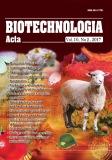"Biotechnologia Acta" V. 10, No 2, 2017
https://doi.org/10.15407/biotech10.02.040
Р. 40-56 , Bibliography 22, English
Universal Decimal Classification: 544.7

WATER BINDING IN COMPOSITE SYSTEMS BASED ON MILLED MEDICINAL PLANTS AND NANOSILICA
V. V. Turov, T. V. Krupska, А. P. Golovan, L. S. Аndriyko, М. Т. Кartel
Chuiko Institute of Surface Chemistry of the National Academy of Sciences of Ukraine, Kyiv
The aim of the study was to identify the influence of hydrodensified nanosilica particles on the binding of water by milled plant raw materials in neutral and acidic media. Flowers of Hibiscus sabdariffa and Calendula officinalis were used as the model materials. According to the microphotographs and low temperature 1H NMR spectroscopy data, the silica film forms on the surface of the milled plant particles, and it can significantly influence their hydration. According to the suggested scheme, some of the water from the inner cavities of plant raw materials moves (as evidenced by the decreasing radius of water-filled pores) to the zone of contact of the composite components (the radius of clusters of adsorbed water increases). In studies of desorption of active substances from milled medicinal herbs and their composites by the initial and hydrodensified nanosilica, it has been shown that the formation of a composite significantly reduces the rate of desorption. Minimal desorption is observed in composites containing hydrodensified nanosilica. The studied composite systems are promising for biomedical researches.
Key words: 1H NMR spectroscopy, hydrodensified silica, Hibiscus sabdariffa, Calendula officinalis.
© Palladin Institute of Biochemistry of National Academy of Sciences of Ukraine, 2017
References
1. Medical Chemistry and Clinical Application of Silica. Eds. A. A. Chuiko. Kyiv: Naukova dumka. 2003. (In Russian).
2. Pogorelyy V. K. Patterns of adsorption of natural bioactive compounds on the surface of silica nanodispersed. Poverkhnost. 2009, 1 (16), 322–349. (In Russian).
3. Georgievsky V. P., Komissarenko N. F., Dmitruk S. E. Biologically active substances of medicinal plants. Novosibirsk: Nauka. 1990, 332 p. (In Russian).
4. Chuiko А. А., Pogorelyy V. К., Barvinchenko V. N., Lipkovskaya N. А., Kovtyuhova N. I., Тurov V. V. Chеmiсal and сliniсal vеrifiсаtiоn оf еffiсiеnсy of drugs belоnging tо thе phytosil fаmily. Chemistry, physic and technology of surface. 1999, V. 3, P. 3–9. (In Russian).
5. Тurov V. V., Gun’ko V. M., Barvinchenko V. N., Rugal А. А., Тurova А. А., Fedyanina Т. V. Hydration of cellulose in the presence of quercetin and organic solvents Chemistry, Physics and Technology of Surface. 2009, V. 15, P. 169–180. (In Russian).
6. Shulga O. V., Kerchhoff J., Turov V. V. The Influence of the Dispersed Oxides on the Interface Energy of the Microcristalline Cellulose in Water Suspension. Methoporous and Microporous Materials. Fiz. Khim. Tekhnol. Poverkhn. 2001, N 4–6, P. 267–274. (In Russian).
7. Gun’ko V. M., Turov V. V., Horbyk P. P. Water on the interface. Kiev: Naukova dumka. 2009, 694 p. (In Ukrainian).
8. Turov V. V., Gun’ko V. M. Clustered water and its application. Kyiv: Naukova dumka. 2011, 313 p. (In Ukrainian).
9. Gun’ko V. M., Turov V. V. Nuclear Magnetic Resonance Studies of Interfacial Phenomena. New York: Taylor & Francis. 2013, 1070 p. https://doi.org/10.1201/b14202
10. Strange J. H., Rahman M., Smith E. G. Characterisation of porous solids by NMR. Phys. Rev. Lett. 1993, V. 71, P. 3589–3591. https://doi.org/10.1103/PhysRevLett.71.3589
11. Petrov O. V., Furo I. NMR cryoporometry: Principles, application and potential. Progr. In NMR. 2009, 54 (2), 97–122.
12. Patent of Ukraine N 105151. Кrupska T. V., Turov V. V., Barvinchenko V. M., Filatova K. O., Suvorova L. A., Kartel M. T. Method of nanosilica condensation. (In Ukrainian).
13. Thermodynamic properties of individual substances Eds. 1978, 495 p. (In Russian).
14. Abragam A. The Principles of Nuclear Magnetism. Oxford University Press, Oxford, UK. 1961.
15. Alyoshyna L. A., Gurtova V. A., Meleh N. V. (ed.) Structure and hysic-chemical properties of cellulose and their nanocomposites. Petrozavodsk: PetrGU. 2014, 240 p. (In Russian).
16. Cellulose and cellulose derivatives. Ed. By N. M. Bikales, L. Segal. New-York; London; Sydney; Toronto: Wiley-Interscience. 1971, 510 p.
17. Hatakeyama T., Nakamura K., Hatakeyama H. Determination of Bound Water Content in Polymers by DTA, DSC and TG. Termochemica Acta. 1988, V. 123, P. 153–161. https://doi.org/10.1016/0040-6031(88)80018-2
18. Heiner A. P., Teleman O. Interaction Between Monoclinic Crystalline Cellulose and Water: Breacdown of the Odd/Even Duplicity. Langmuir. 1997, 13 (3), 513–518. https://doi.org/10.1021/la960886d
19. McMurtrie H., Rikel J. K. The Coloring Review Guide to Human Anatomy. 1990.
20. Turov V. V., Gun’ko V. M., Turova A. A., Morozova L. P., Voronin E. F. Interfacial behavior of concentrated HCl solution and water clustered at a surface of nanosilica in weakly polar solvents media. Colloids Surf. A: Physicochem. Eng. Aspects. 2011, 390 (1), 48–55. https://doi.org/10.1016/j.colsurfa.2011.08.053
21. Gun’ko V. M., Turov V. V., Bogatyrev V. M., Zarko V. I., Leboda R., Goncharuk E. V., Novza A. A., Turov A. V., Chuiko A. A. Unusual properties of water at hydrophilic/hydrophobic Interfaces. Adv. Colloid Interface Sci. 2005, V. 118, P. 125–172. https://doi.org/10.1016/j.cis.2005.07.003
22. Gun’ko V. M., Morozova L. P., Turova A. A., Turov A. V., Gaishun V. E., Bogatyrev V. M., Turov V. V. Hydrated phosphorus oxyacids alone and adsorbed on nanosilica. J. Coll. Interface Sci. 2012, V. 368, P. 263–272. https://doi.org/10.1016/j.jcis.2011.11.018

